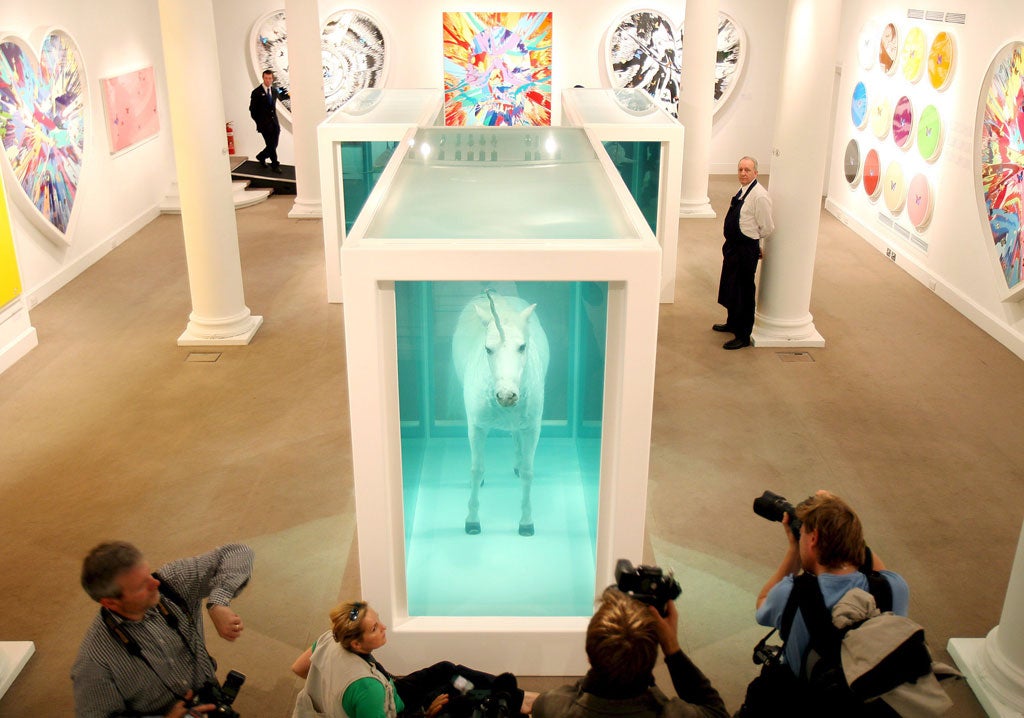What Are You Looking At?, By Will Gompertz
For all its breezy style, this canter through modern art tells the orthodox curator's story.

In my ten years before the mast on the Tate Members' Council, I enjoyed fantastic treats. Access to people and paintings, half-learning how to do curator-speak, seeing the Tate's conservation workshops in action (how do you restore the elephant dung on an Ofili?). And seeing Tate Modern emerge as the most visited modern art gallery in the world.
There were two particular treats in our meetings. One was having Nick Serota ask for the Members' money towards a major acquisition – it made us all feel like Medicis. The other was looking at Will Gompertz's long face and Professor Brainstorm hair, a tonsure surrounded by long blonde bits. At his Tate leaving do, before going off to become the BBC's Arts Editor, they showed a video in which everyone wore a Will wig.The Arts Editor' job is a new big role, created for parity with, say, Robert Peston as Business Editor or Nick Robinson as Political Editor. The story was that a trio of arts panjandrums had bullied the DG, Mark Thompson, into creating this role to recognise the arts, at last, as central to British wealth and happiness. On-screen, Will is breezy, faintly blokey and seems to be engaged in outreach (as in "don't knock it, you might like it").
What are you looking at? is his breezy, faintly blokey, out-reachy summary of 150 years of modern art – or as breezy as you can get with nearly 400 pages of text. I'm not quite sure who it's for. It reads quite like television in the making. There are very TV-ish anecdotes about Marcel Duchamp buying the revolutionary urinal (in New York, 1917) and Eduardo Paolozzi in his Italian parents' ice-cream parlour in Edinburgh, but it remains quite densely plotted as well. The market here should be for something beyond the late Robert Hughes's 1980s series The Shock of the New, but the writing and the insights don't work at that level.
Gompertz starts, rightly, with that Duchamp moment: that declaration that modern art is about the primancy of ideas, rather than craft skills. That a clever idea can be realised in any way that works, and still be compelling. After that he backtracks to the Impressionist breakthrough of the 1870s and explains that, however comfortable the group's work looks now, there was a real struggle against a real Establishment, the Academy, with a real power of veto. By comparison, the YBAs were simply young marketeers following an old business-art model with an eager, global audience.
Then on, through the "isms", the canon, to a final chapter covering 1988 (Damien Hirst and his Goldsmiths' friends 'Freeze' exhibition), and to September 2008, when the big Sotheby's Hirst sale just pulled it off. It sold £111 million of work on the day that Lehman Brothers was falling apart, the end of turbo-capitalism as we knew it. Between those points it's quite a slog, however, because the expectations raised by the breezy prose and the mass-culture references is that we'll get to a new take on the development of audiences and markets: something beyond a competent walk through the isms.
But despite the obligatory acknowledgement that "art people talk bollocks sometimes", his approach remains relentlessly conventional. And he is relentlessly positive about practically all the consecrated major works. Like that McCann advertising theme, "It's all good".
The problem with following the isms – what Tom Wolfe called "the trend that walks like a man" in his brilliant right-wing polemic on art criticism, The Painted Word – is that, however demotic the language, you're still following the curatorial-critical priesthood's version of events, and the media version of value.
I wanted more than this perfectly acceptable tour. I wanted more cross-reference to the 150 extraordinary years of social, technological and economic change behind all these developments. I wanted more about markets – the kind of global money that buys art as an asset class in an investment portfolio now. I wanted more about audiences, and the expectations visitors to, say, Tate Modern or MOMA New York bring to their experience. I wanted some acknowledgement of the world outside art-land and artists.
My other problem is with the coverage, not of isms but artists. This is clearly a book for the Anglosphere because it barely acknowledges that whole parallel universe of contemporary art outside the West (Frida Kahlo and Ai Weiwei mainly). Yet when we get to Blighty, great swathes of "Modern British" artists – who define the Englishness of English art – are cheerfully ignored in favour of the received canon. I'm not making a case for the second-tier Bloomsbury artists, nor even John Piper or Paul Nash; but what they represent, though hardly an ism, does amount to a cultural insight.
This year the Tate mounted a wonderful exhibition. Picasso and Modern British Art showed how a range of British artists from the first tier – Francis Bacon, Henry Moore – and the second – Duncan Grant, Wyndham Lewis – had produced work quite slavishly imitative of Picasso before they variously found their feet. What this tells us about ourselves and the momentum of the art market is one thing I'd love to have heard more about. And I'd love to have heard Will Gompertz's take on Nat Tate, William Boyd's compelling, plausible invented American artist. Now that is conceptual art.
Subscribe to Independent Premium to bookmark this article
Want to bookmark your favourite articles and stories to read or reference later? Start your Independent Premium subscription today.

Join our commenting forum
Join thought-provoking conversations, follow other Independent readers and see their replies